Who Controls the User Experience? AMD’s Carrizo Thoroughly Tested
by Ian Cutress on February 4, 2016 8:00 AM EST#3 The Toshiba Satellite E45DW-C4210 (Carrizo, FX-8800P)
If E45DW-C4210 comes in as a mouthful relevant to very few people, you are probably right, so we’ll just refer to it as the Toshiba Satellite from here on in. Having a Satellite for testing this piece was somewhat amusing, given I had recently bought one for my grandparents and upgraded it (there’s a separate mini-review of that coming later), and wasn’t sure if what I had found on my grandparents' model would also be found here.
| Toshiba Satellite E45DW-C4210 (Carrizo) Specifications | |
| Size and Resolution | 14-inch, 1366x768 TN with Touch |
| Processor | AMD FX-8800P Dual module, 4 threads 2.1 GHz Base Frequency 3.4 GHz Turbo Frequency |
| Graphics | Integrated R7 512 Shader Cores 800 MHz maximum frequency GCN 1.2 |
| TDP | 15W |
| Memory | 8 GB in Single Channel Operation 1 x 8GB at DDR3L-1600 C11 1 SO-DIMM Slot Only |
| Storage | 750GB Toshiba HDD |
| Battery Size | 45.298 Wh 3 cell Li-Ion design |
| WiFi | Realtek 8821AE 802.11ac 1x1 |
| Optical Drive | No |
| Dimensions | 13.3 x 9.3 x 0.83-inch 337.4 x 235.0 x 21.05 mm |
| Weight | From 4.5 lbs (2.05 kg) |
| Webcam | 1280x720 |
| Other Features | Memory Card Reader HDMI 2 x USB 3.0 + 1 x USB 2.0 |
| Operating System | Windows 10 Home |
This model of Satellite gets the top-end FX Carrizo processor, the FX-8800P, which is a dual module/quad core design with a 2.1 GHz base frequency but a 3.4 GHz turbo frequency. Because the FX line still exists in AMD’s mobile processors, it means it gets top tier graphics as well, which for integrated graphics means 512 streaming processors running at 800 MHz. This is pretty much the top end AMD integrated graphics configuration that anyone can buy, save a pre-overclocked system. To continue with the plus points in the hardware, the Toshiba was also fitted with a Realtek 8821AE Wi-Fi card which also follows the 802.11ac M.2 standard as described in the 745 G3 but this is a single stream version, which limits 802.11ac benefits such as beam forming.
Then, the downsides begin, or where Toshiba saved some money. The display is a pretty bad 1366x768 TN panel that didn’t want to play ball with our display testing equipment, but was surprisingly touch enabled which made things better when you used the ‘Devil’s Trackpad’. With no offence intended towards Toshiba, I seriously wrote that in my notes while I was testing, and that isn’t a good thing. The nearest thing to this trackpad would be the ‘off’ position. I’m not sure if it was a bad sensor, a poor sensor, something with the coating or what, but one of the worst things a laptop can do when being tested is when the tester wants to throw it across the room. The solution would be to insert a mouse, forget about it, and then 'remember how much you saved'. Unfortunately that race to the bottom on trackpads ends up a negative feedback loop for all concerned.
On the storage side, a combination 8GB of memory (single channel DDR3L-1600, naturally) and a 750 GB mechanical hard disk left the model with few plus points aside from the top end processor.
The Design
So firstly, the design of this Satellite one is more towards brushed metal for a sleeker look.
Functionally, there are a number of good and bad points to list. Despite the brushed metal finish on the top, the design is actually mostly plastic, with two vents at the rear for airflow. The hinge is also a 360º hinge as part of the Radius range.
One of these is an intake and the other is the exhaust, which at least keeps all the warm air out of the back of the laptop, although anyone using the laptop on their lap might be able to feel it depending on the workload. If the warning sticker is anything to go by:
CAUTION!
PC BASE CAN BECOME HOT!
AVOID PROLONGED CONTACT
TO PREVENT HEAT INJURY TO SKIN
You have to wonder – is that an AMD problem due to heat generation, or a Toshiba problem due to bad heat soak of plastic design? Either way, there are other 15W devices that don’t have these warnings.
The sides have two USB 3.0 ports, a HDMI port, the Kensington lock port, a USB 2.0 port, audio ports, a volume rocker, a power connector and a specific button to enter Tile Mode in windows.
The brushed metal finish is also on the cover, and again this was an AMD shelf model featuring a few scrapes but nothing too noticeable at a quick glance.
The audio arrangement is provided by Harman/Kardon, and the keyboard uses equal sized separate buttons for the arrow keys as well as the regular delete/home/end set. There are no quick buttons for mute or airplane mode however.
The trackpad on the specific device we tested was absolutely terrible. The only practical way to use this laptop was to use a mouse.
On the display side of things, as noted above for some reason this unit would not get along with our colorimeter, crashing each time we tried to take a reading. The 45.298 Wh battery gave the following charge profile:


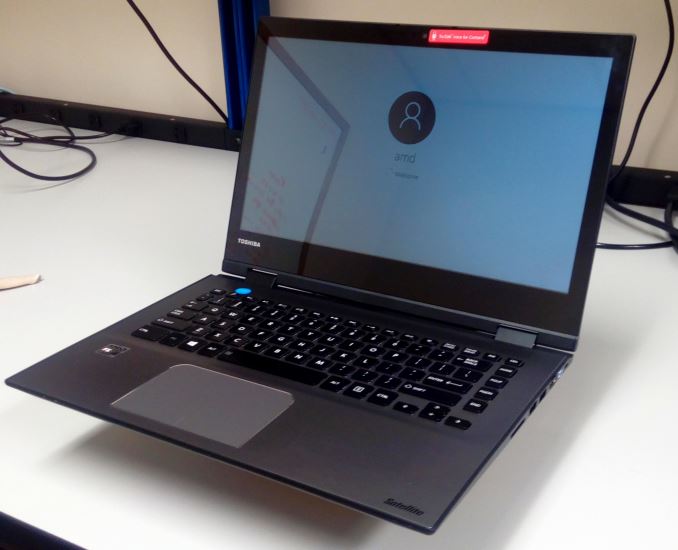










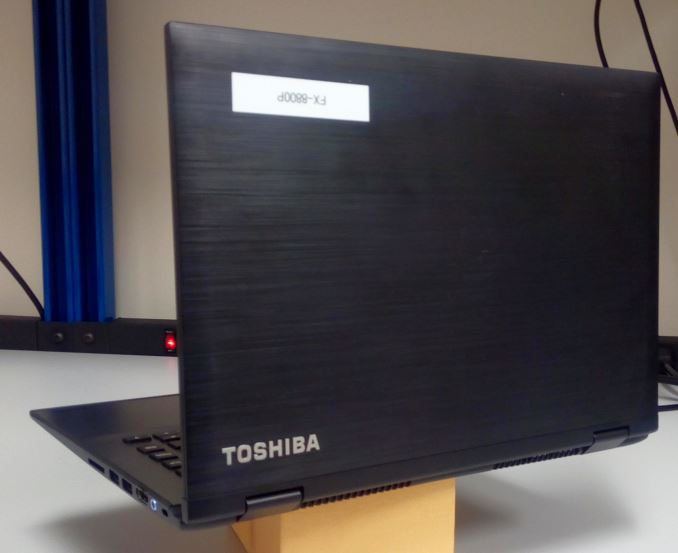
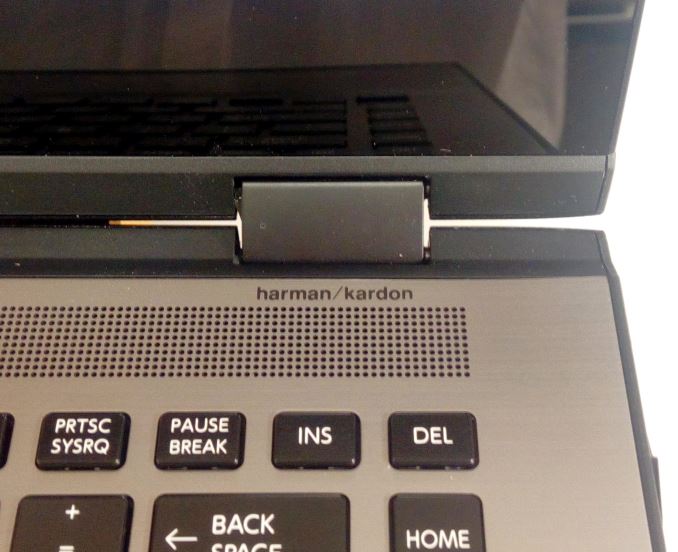
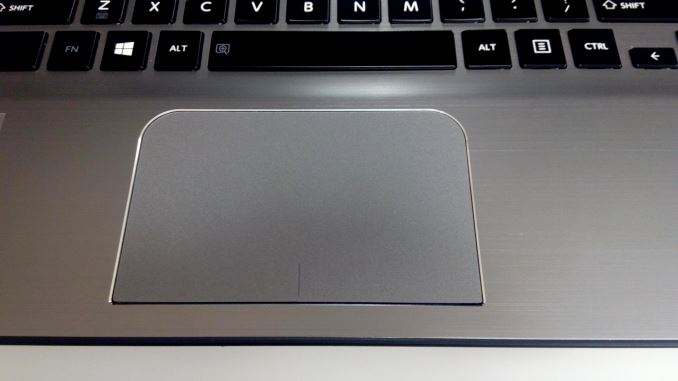
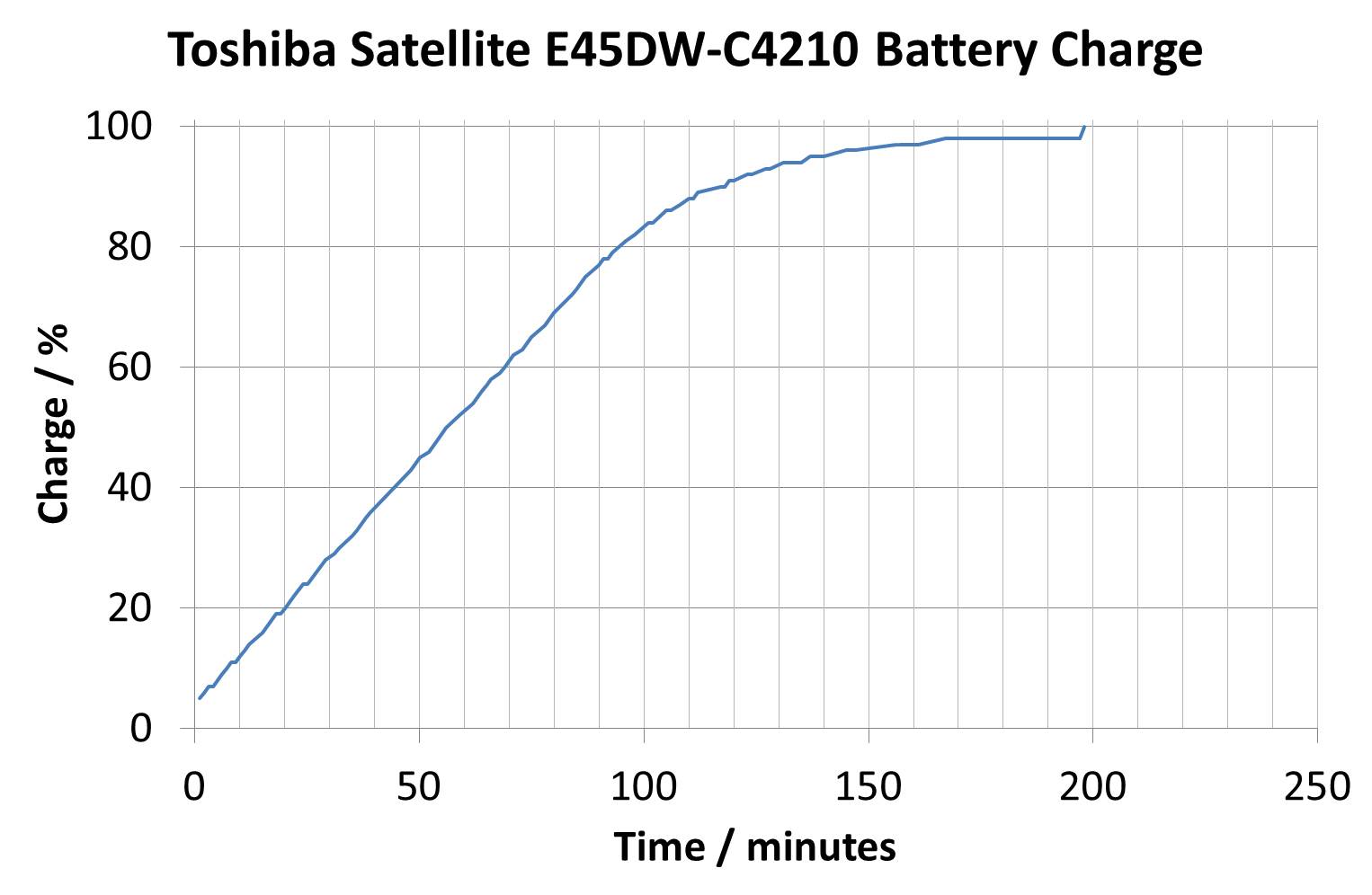








175 Comments
View All Comments
yannigr2 - Friday, February 5, 2016 - link
The 845 doesn't have an iGPU. You threw away the chance to directly compare the color compression advantage of Carrizo's GPU in a very limited bandwidth scenario like this one by either removing one dimm from the Kaveri laptop or adding another one in one of the Carrizo laptops. I wouldn't ask why. Thanks for the article.FriendlyUser - Saturday, February 6, 2016 - link
Thank you for this extensive article. Many people seem to dismiss AMD CPUs today without actual data. I commend your efforts to examine all aspects of real systems. I'll be waiting for the data from 845 (which sound like a decent upgrade for a NAS...).Keep up the good work.
JMC2000 - Sunday, February 7, 2016 - link
This is something I've been interested in since AMD released the 845 (wasn't there a Phenom II-based Athlon 845? I know there was a Phenom II 845...). Shame that they chose not to release an A12/FX Carrizo APU, those 512 shaders could be nice...mczak - Friday, February 5, 2016 - link
I agree with that, it's _really_ missing results with dual channel. I understand why single-dimm configurations were tested, but at least two of the notebooks had the option to use dual channel, and even if it might be difficult to get preconfigured options with dual-channel, it's easily upgradeable - I'm also interested in what Carrizo can do as a chip, not only what it can do if sufficiently crippled by the OEM.(Not that I expect wonders with dual channel though, at least not at 15W where the graphics doesn't run with more than half the max clock anyway, but still...)
Ian Cutress - Friday, February 5, 2016 - link
On the chip side, we'll do a full breakdown of perf and IPC when we get our hands on the desktop version in Athlon X4 845. I'm hoping to get some R-Series too, and we can do DDR3 vs DDR4 on AMD as well. That might provide a better pure comparison which I know some users want to see. I do too :)bojblaz - Friday, February 5, 2016 - link
Excellent, excellent article. Lucid questions asked and answers pursued - we need more of this kind of journalism. I can't praise this enough.It would have been really interesting to see the results had you filled the second SODIMM on the laptops that supported dual channel? I assumed time constraints prevented you from doing so. Also any chance of going to the OEMs directly and asking them why they make the decisions they make?
Lolimaster - Friday, February 5, 2016 - link
That's like givin 5 tons of deadweight to pre-Raditz-Vegeta saga Goku. AMD, why even bother, release your products under Ruby brand or something...TheinsanegamerN - Thursday, February 11, 2016 - link
I second that. A proper 13 inch design with a 35 watt 8800p, none of this hybrid graphics stuff, and good battery life, would be an insta-buy. Or 14 or 15 inch. I just want something like my old lenovo e535, but smaller. It cant be THAT hard, can it?nfriedly - Sunday, February 7, 2016 - link
Agreed. This article was basically a long-winded way of saying "all current AMD laptops suck, and we aren't even sure how good they could be because *all* the OEMs half-assed their designs"I, for one, would be very interested in an AMD designed laptop.
Cryio - Sunday, February 7, 2016 - link
Apparently AMD wants to push 28 nm even farther with Bristol Ridge, maybe better binned chips and hopefully DDR4 support will provide a much needed boost.